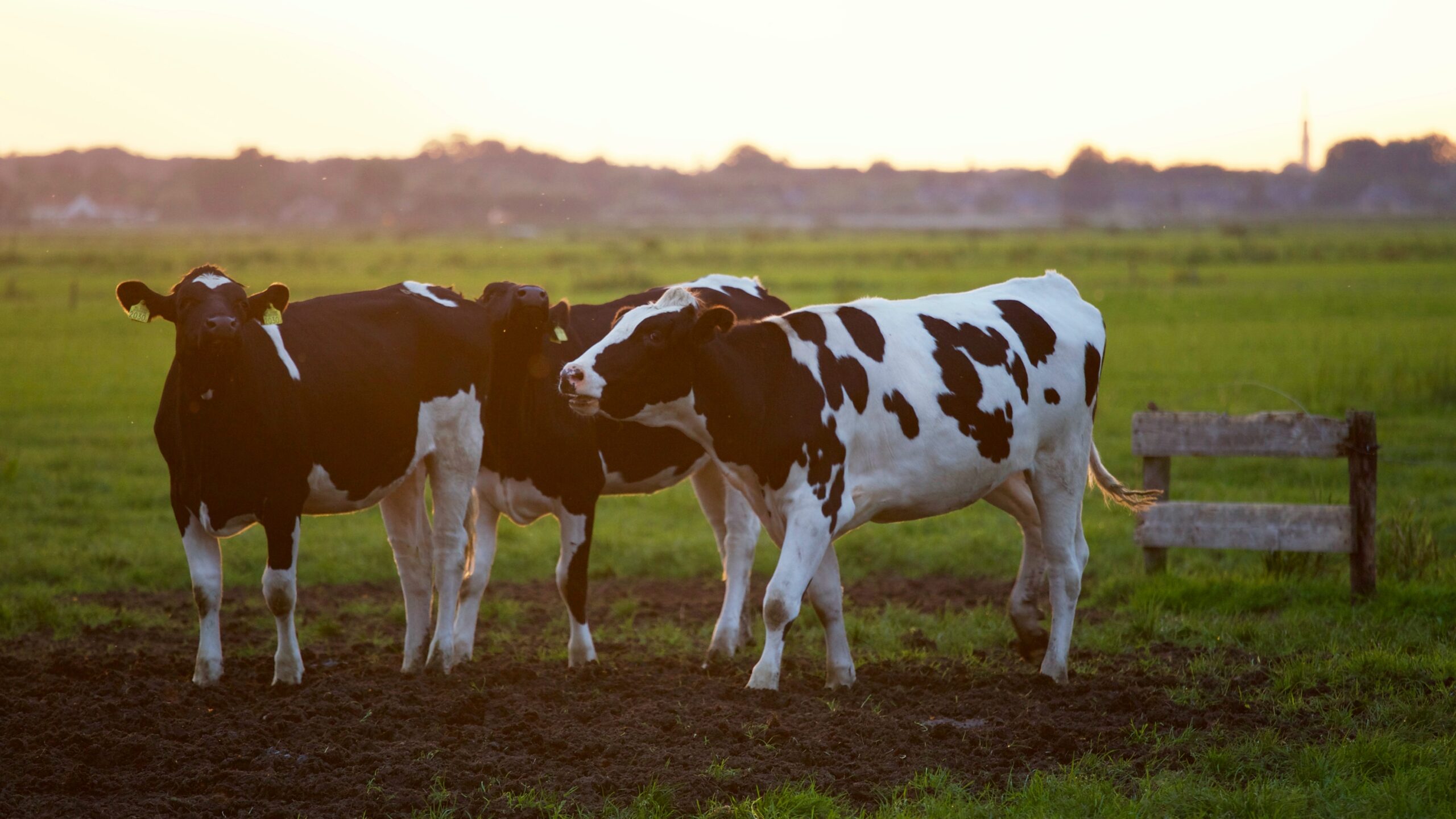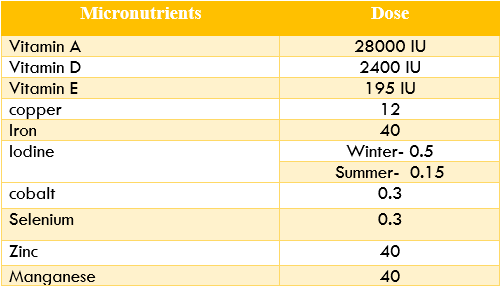
Introduction
Micronutrients are one of the major groups of nutrients essential for the body. They are vitamins and minerals in minute amount. For proper functioning of animals body, in addition to protein, fat and carbohydrate, minerals and vitamins are also required in smaller amount to prevent deficiency disease in animals. Among indispensable nutrients, significant role is played by macro (calcium and phosphorus) and micro-elements (Copper, zinc, iron, cobalt, manganese, iodine and selenium), either independently or collectively in reproduction of farm animals. However, vitamins deficiencies are unlikely to occur in most dairy herds. Except vitamin A, as the requirement of all other vitamin frequently met by a combination of rumen and tissue synthesis and from natural feeds. The only vitamins shown to be involved in reproduction of farm animals are vitamin A, D and E.
Copper
It is necessary for normal connective tissue maturation and normal hemoglobin and red blood cell developments. High levels of molybdenum, sulfur, iron or zinc in the diet interfere with normal copper absorption and metabolism. Copper deficient diet delayed onset of puberty, repeat breeding, low conception, early embryonic mortality and increased incidence of retention of placenta. In male copper deficiency leads to decrease libido, lower semen quality, and severe damage of testicular tissue may render the bull sterile.
The fertility can be restored on supplementation of 10 g copper sulphate & 2 g cobalt sulphate daily for a period of 3 weeks.
Cobalt
It is essential for microbial synthesis of vitamin B12 in ruminants. The requirements of cobalt is higher when cattle are fed high grain diets, because more vitamin B12 is required to metabolize the end products of rumen fermentation. The clinical signs of cobalt deficiency are delay in onset of puberty, anemia, general unthrifitiness, delayed uterine involution and decrease conception rate and could be corrected by supplementation of 20-25 mg cobalt sulphate or chloride / 100 kg body weight.
Iodine
It’s important for growth, reproductive performance and lactation in farm animals. Adequately dietary daily intake of iodine is therefore of considerable importance. Iodine is required for synthesis of the thyroid hormones (T3 and T4). Signs of iodine deficiency related to reproduction include delayed puberty, cessation of estrus activity and an ovulatory estrus periods. When an iodine-deficient diet is fed during pregnancy, cow may deliver weak or dead, hairless calves. Cow may also abort and have an increased incidence of retained placenta and calves may be born with goiter. In iodine deficient areas, favorable results have been reported in repeat breeding cows by feeding of 20-40mg of an organic iodine preparation daily from 8-18 days before the onset of estrous.
Manganese
Manganese levels in forage vary considerably, depending on the soils on which they are grown. manganese actively participate in redox processes, tissue respiration and bone formation and affects growth and reproduction.
Its required for activation of many enzyme systems and may be involved in luteal tissue metabolism. A deficiency has been reported to result in silent estrus, infertility, abortion, and birth of calves with deformed or twisted legs. Absence of libido and failure of spermatogenesis in male animals are very common. In cystic cows, low level on manganese has been reported in ovarian tissue than normal cows. Since granulosa cells of ovary require manganese for follicular development, its deficiency might lead to degeneration of granulosa cells.
Zinc
Zinc is required for various enzyme as a cofactor related to reproduction. Deficiency of zinc may leads to make infertility and to the reduction of size of testes. Zn deficiency can adversely affect the spermatogenesis, testicular growth and the development of primary and secondary sex organs in male and all phase of reproductive process in females from estrus to parturition to lactation. Zinc has a significant role in repair the maintenance of uterine lining following parturition and early return of post partum estrus. Zn deficient animals have been shown have lower concentration of FSH and LH chiefly in males. Zn deficiency in male cause atrophy of seminiferous tubules and inefficient testicular development in young ones, leading to reduced testicular size, lack of libido and can adversely affect spermatogenesis.
Iron
Since most forage contains high levels of iron and because substantial amount of soil are consumed during grazing, iron is almost never deficient in cattle fed forage-based diets. In case of animals having diet deficient in iron the animals suffer from deficiency disease. The most common symptoms of iron deficiency is microcytic and hypochromic anemia. A more common problem with iron is that it may be excessively high in forage or in drinking water, which can interfere with the absorption of copper and zinc.
Selenium
It is an integral component of the glutathione peroxidase enzyme. The marginal selenium deficiency can result in retained placenta, impaired fertility, silent heats and unthrifty weak calves with poor immune response and reduced sperm motility in males. Feeding most common types of rations, especially legumes will prevent these deficiencies. Although selenium deficiency is sporadic but it impairs the reproduction.
Vitamins
Though required in minute amount as compared to protein, carbohydrates and fats but vitamins play a significant role in animal health, production and reproduction. Fat soluble vitamins like A, D and E has special significance in reproduction of farm animal.
Vitamin A
This is available in most green plants, and if the animals graze on well managed pastures and forage, deficiencies will not occur. However, cattle fed on poor quality roughage, such as poor quality hay and straw, require supplementation. Vitamin A deficiency adversely affects reproduction in most species and effects are manifested during the later half of gestation. Which are characterized by birth of weak and dead calves. Vitamin A deficient animals have normal estrous cycle, ovulate and conceive, early fetal development occur even though epithelial and other tissue changes have developed. The clinical signs associated with vitamin A deficiency in cattle include delayed onset of puberty, abortion or birth of weak, blind, in-cordinated calves, suppressed libido in male. Diets deficient in ß-carotene but adequate in vitamin A have been shown to cause delayed ovulation, silent estrous, extended follicular phase, anovulation and delayed involution of uterus.
Vitamin D
There is little vitamin D in plants. Animals obtain most of it from the sun. Vitamin D is necessary for the absorption of calcium and phosphorous from the intestines and the deposition of the minerals in bone as well as in the maintenance of normal blood levels. Vitamin D deficiency in young calves is likely to occur when they are housed in dim lights and offered poor quality diets. Vitamin D deficient pregnant cows produce calves with rickets, whereas non-pregnant cows fail to exhibit estrous cycles.
Vitamin E
It’s a potent antioxidant compound that protects the cell membranes. Moreover, when combined with vitamin C, it has shown even stronger antioxidant properties. Effect of vitamin E occurs directly or indirectly on the regulation of intra-testicular factors which regulate specific steps of germ cell development. The other aspects that is its reproductive function is associated with selenium. Prepartum supplementation of vitamin E reduces the recurrence of retained fetal membrane.
Cause of mineral deficiency
Presence or absence of particular mineral nutrients in animals feed in specific geographical area depend on the farming practices. Heavy application of nitrogen fertilizer reduced in the concentration of various micro minerals (copper, cobalt, molybdenum and manganese) content in the pasture, likewise lime application reduce plant copper, cobalt, zinc and manganese levels and increase in the molybdenum content. In tropical regions marked leaching and weathering of soils under conditions of heavy rainfall and high temperatures make the deficient in plant minerals. Increasing crop yields remove minerals from the soil at a faster rate so deficiencies are frequently found on the most progressive farms. Even though a diet may contain adequate amounts of particular nutrients, other factors decrease the absorption of that nutrient, thus reducing the value of the dietary supplements. High levels of phosphorus reduce zinc and, to a lesser degree, calcium uptake. It is antagonistic to boron in low pH soils. High levels of copper can accentuate molybdenum and to a lesser degree iron, manganese and zinc deficiency. Iron deficiency can be accentuated by liming, low potassium levels or high levels of copper, manganese or zinc. Uptake can be decreased by high phosphorus levels, liming or high levels of copper, iron or manganese. Zinc deficiencies are often associated with manganese deficiencies.
So mineral imbalance ( excesses or deficiencies) in soils and pasture may be responsible for low production and reproduction problems among grazing animals in the tropics. Thus, it is necessary to provide these elements as dietary supplements to promote efficient and profitable livestock production and reproduction.
Also, read | Need of Environmental Controlled Housing in Livestock
Table- Dietary allowances of minerals (mg/kg DM) and vitamin (IU) for adult cow

Authors:
Pramod Chaudhary1*, Ashutosh Semwal 2, Pankaj Choubey3, Alisha Sharma3
1Ph.D. Scholar, Division of Animal Nutrition, Indian Veterinary Research Institute, Izatnagar, Bareilly-243122 (Uttar Pradesh, India)
2Ph.D. Scholar, Department of Veterinary Anatomy, College of Veterinary and Animal Sciences, G.B. Pant University of Agriculture and Technology, Pantnagar-263145, Uttarakhand
3M.V.Sc Scholar, Division of Animal Nutrition, Indian Veterinary Research Institute, Izatnagar, Bareilly-243122 (Uttar Pradesh, India)
*Corresponding Author: Pramod Chaudhary: pramodchaudhary2277@gmail.com

















